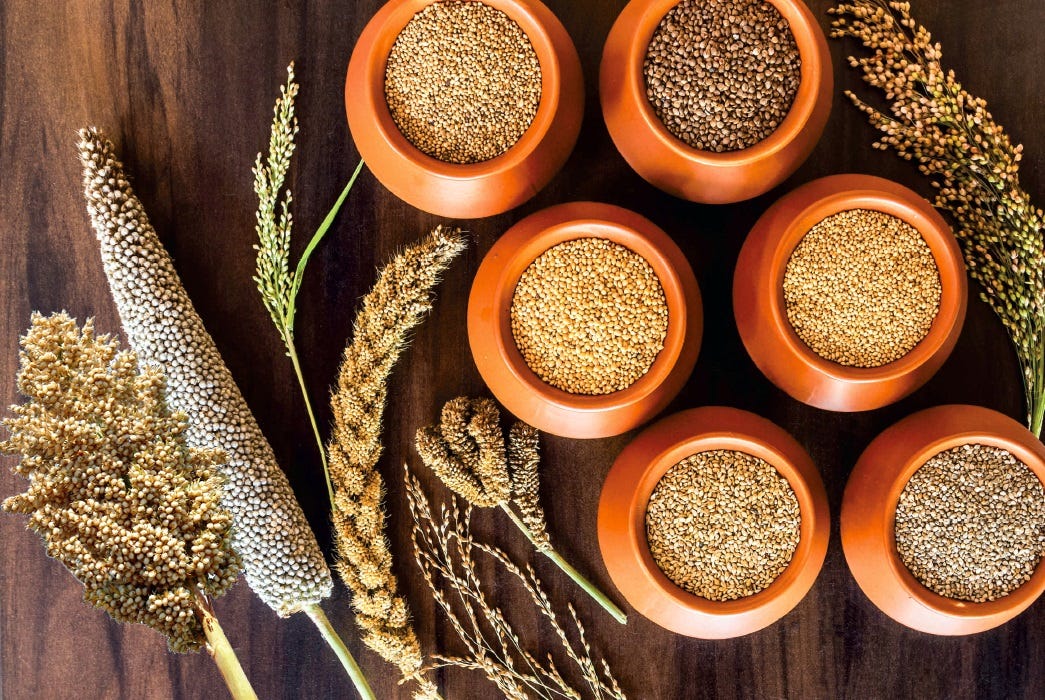

Millet: Nutrition, Health Benefits and Uses
Introduction to Millet
Millet, small cereal grains belonging to the Poaceae family, has gained popularity in various regions due to its exceptional nutritional content and gluten-free nature. It is preferred over traditional grains due to its numerous health benefits.
Millet has been a staple in many cultures for centuries and is now gaining recognition for its exceptional nutritional value. This ancient grain is a powerhouse of essential nutrients and offers a range of health benefits. In this article, we will explore the nutritional profile, health benefits, potential side effects, and culinary uses of millet.
Nutritional Profile of Millet
Millet is a powerhouse of nutrition, containing carbohydrates, protein, fat, and essential minerals. It is high in amino acids, calcium, and antioxidants, which have potential health impacts. The exact nutritional composition can vary between different types of millet, but in general, it is a rich source of nutrients essential for overall health and well-being.
Health Benefits of Millet
Digestive Health
Millet is a rich source of dietary fiber, which plays a crucial role in digestive health. The high fiber content of millet promotes regular bowel movements, prevents constipation, and supports a healthy digestive system. Additionally, millet contains prebiotics, which nourish the beneficial bacteria in the gut, further enhancing digestive health.
Gluten-Free Diets
For individuals following a gluten-free diet due to celiac disease or gluten sensitivities, millet serves as an excellent alternative to gluten-containing grains. Its gluten-free nature allows individuals with gluten intolerance to enjoy a wide variety of dishes without compromising their dietary restrictions.
Blood Sugar Control
The fiber content and low glycemic index of millet make it an ideal food for supporting healthy blood sugar levels. Consuming millet can help regulate blood glucose levels, making it a valuable addition to the diet of individuals managing diabetes or those at risk of developing the condition.
Cholesterol-Lowering Properties
Millet contains soluble fiber, which has been associated with lowering levels of LDL cholesterol, often referred to as "bad" cholesterol. By including millet in a balanced diet, individuals may help reduce their risk of cardiovascular diseases associated with high cholesterol levels.
Heart Health
Magnesium, a vital mineral found in millet, plays a crucial role in promoting heart health. Adequate magnesium intake has been linked to a reduced risk of cardiovascular conditions, making millet a heart-healthy grain. Additionally, millet contains adiponectin, a protein hormone that has anti-inflammatory and insulin-sensitizing properties, further contributing to heart health.
Mood Enhancement
Millet contains tryptophan, an essential amino acid that serves as a precursor to serotonin, a neurotransmitter associated with mood regulation. Including millet in the diet may help support mental well-being and contribute to a positive mood.
Weight Management
Millet's combination of low-calorie, high-fiber, and protein-rich content makes it a valuable food for individuals looking to manage their weight. The satiating properties of millet can help individuals feel full and satisfied, potentially reducing overall calorie intake.
Potential Side Effects of Millet
Thyroid Function Impairment
While millet offers numerous health benefits, it contains goitrogenic polyphenols that may interfere with thyroid function. Individuals with existing thyroid conditions or those at risk of thyroid disorders should consume millet in moderation and consult with a healthcare professional if necessary.
Digestive Distress
Some individuals may experience digestive distress, such as bloating or gas, when consuming millet. To mitigate these symptoms, it is advisable to introduce millet gradually into the diet and ensure it is prepared and cooked appropriately to enhance digestibility.
Kidney Stones
Individuals prone to developing kidney stones should exercise caution when consuming millet. Millet contains oxalates, compounds that can contribute to the formation of kidney stones. Moderation and adequate hydration are essential for individuals at risk of kidney stones.
Allergenic Reactions
As with any food, some individuals may experience allergic reactions to millet. It is important to be aware of potential allergenic responses and seek medical attention if allergic symptoms occur after consuming millet.
Nutritional Considerations
While millet can contribute to weight management, individuals should consider the overall balance of their diet. Incorporating millet into a well-rounded, nutrient-dense diet is essential for maximizing its health benefits.
Culinary Uses of Millet
Soaking and Sprouting
To enhance the nutritional value of millet and reduce antinutrients, such as phytic acid, soaking and sprouting can be employed. This process can improve the digestibility and nutrient absorption of millet.
Cooking Instructions
Cooking whole millet is a simple process that yields a light, fluffy texture. By following specific cooking instructions, individuals can prepare millet to perfection, making it a versatile ingredient for various dishes. To cook millet, combine one part millet with two and a half parts water in a saucepan. Bring the water to a boil, then reduce the heat, cover, and let the millet simmer for approximately 25 minutes or until the grains are tender and the water is absorbed.
Applications
Millet's versatility extends to its applications in a wide range of culinary creations. It can be used to prepare nutritious baked goods, such as bread, muffins, and cookies, adding a wholesome touch to these treats. Additionally, millet flour can be incorporated into gluten-free baking recipes, allowing individuals with gluten sensitivities to enjoy a variety of baked delights. In snack preparations, puffed millet can be utilized to add a delightful crunch to granola bars or trail mixes, enriching these snacks with its nutritional benefits. Furthermore, millet can be transformed into delectable pasta, offering a gluten-free alternative for pasta lovers. Its mild flavor and adaptable texture make it suitable for both sweet and savory dishes, contributing to the diversity of culinary creations.
Integration into Various Meals
Millet's versatility shines through in its integration into a multitude of meals, enhancing both the nutritional value and sensory appeal of these dishes. In savory preparations, millet can be featured in flavorful pilafs and hearty salads, providing a satisfying texture and nutritional depth to these dishes. Its mild, slightly nutty flavor complements a variety of ingredients, making it a versatile addition to culinary creations. Additionally, millet can be utilized to prepare nourishing soups, offering a wholesome base for comforting and nutritious meals. In breakfast offerings, millet can be transformed into a creamy and satisfying porridge, enriched with fruits, nuts, and spices, catering to a delightful start to the day. Its adaptability in diverse meal preparations allows individuals to explore its culinary potential while reaping the nutritional benefits it offers.
Conclusion
In conclusion, the exploration of millet's nutrition, health benefits, potential side effects, and culinary uses underscores its significance as a versatile and nutritious grain. Its rich nutritional profile, encompassing essential nutrients such as dietary fiber, protein, vitamins, and minerals, positions it as a valuable addition to a balanced diet. Whether consumed for its digestive health benefits, support for gluten-free diets, or contributions to heart health and weight management, millet stands as a testament to the diverse benefits offered by whole grains.
The culinary applications of millet further accentuate its appeal, offering a canvas for both traditional and contemporary culinary expressions. From nourishing breakfast porridges to savory pilafs and delectable baked goods, millet invites culinary exploration, adding a wholesome touch to a myriad of dishes. Its adaptability in diverse culinary creations enables individuals to savor its nutritional benefits while indulging in a variety of satisfying meals.
As individuals continue to prioritize diverse and nutrient-rich foods, millet emerges as an enticing option for enhancing dietary diversity and inclusivity. Its gluten-free nature and exceptional nutrient profile make it a valuable addition to the dietary landscape, catering to the nutritional needs and preferences of a wide audience.
The enduring legacy of millet as an ancient grain resonates through its nutritional virtues, culinary potential, and inclusive nature. As we celebrate the rich tapestry of dietary experiences, let us embrace millet as a symbol of nourishment, inclusion, and culinary inspiration, embracing its presence on our plates with creativity and appreciation.
In the ever-evolving journey of culinary exploration and dietary enrichment, millet stands as a steadfast companion, offering a wealth of nutritional benefits and culinary possibilities. Let us continue to savor the wholesome allure of millet, embracing its contributions to our well-being and culinary adventures.
